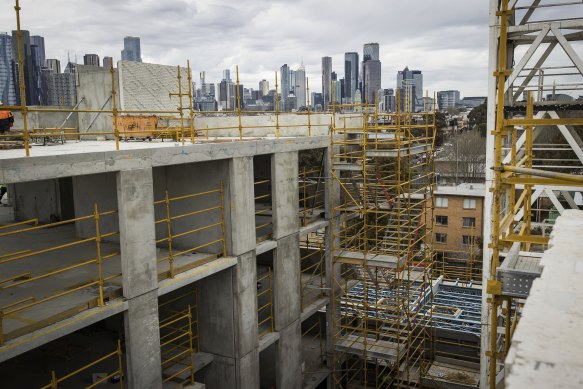This was published 2 months ago
Why build-to-rent is booming in Melbourne only
By Simon Johanson and Nicole Lindsay
Renters in Melbourne are being given more choice than their Sydney counterparts as the “build-to-rent” sector takes off in the southern state, leaving the rest of the country to play catch-up.
While traditional high-density development is in the doldrums, build-to-rent apartments have almost doubled in the past year, swelling to more than 40,000.

Build-to-rent projects could account for a sizeable proportion of much-needed apartment projects.Credit: Darrian Traynor
Well over half (58 per cent) are under development in Melbourne, JLL research suggests. Brisbane and then Sydney make up the majority of the remainder. If enough projects finish this year, they will make up about 10 per cent of an average year’s new apartment supply.
Australia’s housing crunch is putting pressure on all levels of government.
Build-to-rent apartments are usually owned by pension funds or other large-scale property landlords, who maintain the buildings and rent the units to tenants, often on a long-term basis. They are seen as a viable means to rapidly increase housing supply.
Rents across the country have skyrocketed as vacancy plummeted, with high interest rates raising the barrier for new home owners as inflation eats into static incomes. At the same time, soaring construction costs have slowed home building, just as record levels of migration add more demand for housing.
Treasurer Jim Chalmers’ budget last year halved withholding tax rates for foreign investors in managed investment trusts and accelerated tax depreciation for eligible build-to-rent projects in a bid to support the sector, but the changes are being held up in the Senate.
As well, state governments have reduced land tax on eligible projects or introduced a range of other measures.
JLL, a commercial real estate agency, said it was now tracking 40,631 build-to-rent apartments at various stages of development, up by 98 per cent since December 2022.
The agency’s head of residential research in Australia, Leigh Warner, said Melbourne’s strong population growth and the availability of large-scale, high-density redevelopment sites were behind the sector’s growth.
“Build-to-rent works best at scale, and there are a lot of sites in inner Melbourne that are perfectly located next to transport and other amenity where developers have been able to work up large-scale build-to-rent schemes,” Warner said.
Sydney’s high cost of land, by contrast, makes it much more difficult to stack up projects.
“Developers desperately want to do more in Sydney because the lack of housing affordability is driving strong rental demand,” he said.
Daniel Grollo, a developer who already has three build-to-rent projects on the go, is taking advantage of both location and demand in Melbourne.
His company, HOME, has just opened its latest property, a 676-unit twin-tower project in Docklands, across the road from Marvel Stadium at 685 La Trobe Street.

The Smith Street Woolworths is topped by an empty facade which has loomed over the sreet for nearly 40 years. Now, 115 units are planned to go there.Credit: Eddie Jim.
Casa, his separately run development group, is also planning another 115-unit project - where it will sell the apartments rather than rent – on Melbourne’s uber-trendy Smith Street, in the inner north, above what is now a Woolworths supermarket.
The Sydney-based Roth family has sold Grollo the Woolies building, which they paid $13.55 million for in 2001 to a fund controlled by the Uniting Church.
The building is topped by an empty facade that has loomed over Smith Street for nearly 40 years, typifying the downbeat vibe of the strip, which has gentrified in the past decade.
The prime 4000-square-metre Fitzroy site, calculated to have cost around $40 million, is now poised for renewal as an 11-storey apartment project, according to plans lodged with the City of Yarra.
Another developer, Suleman Group, is in advanced negotiations to sell a completed two-hectare, build-to-rent apartment complex with a substantial retail component, estimated to be worth an estimated $350 million.
The project, called Union Quarter, is being sold through Colliers.
The freehold site in Spotswood, in Melbourne’s inner west, returns $18.3 million in annual income and includes major tenants Woolworths and Dan Murphy’s, along with other traders on the ground floor retail. Above are 332 apartments.
Negotiations have been whittled down to one party after 39 international and local groups expressed interest.
The Spotswood sale will be significant as no other functioning large-scale build-to-rent project has yet changed hands in Australia.
“This will be a benchmark transaction that will ripple through the entire country,” said Suleman’s development manager, Zoran Pavlovic.
Pavlovic would not comment on the expected price but said that Suleman started the project as a counter-cyclical play when major banks weren’t funding the nascent build-to-rent sector.
Institutional investors, turned off by the office sector’s troubles, were now looking at build-to-rent for better returns, he said.
JLL said there was very limited data on how build-to-rent assets were performing in Australia because no large-scale projects had yet been sold. That’s expected to change in the near future as more come on the market, they said.
The Market Recap newsletter is a wrap of the day’s trading. Get it each weekday afternoon.
correction
An earlier version of this story incorrectly referred to the Grollo’s Smith Street project as build-to-rent. The apartments will be sold individually.